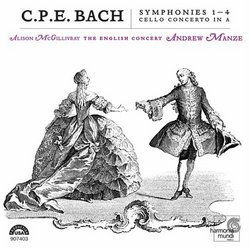| All Artists: C.P.E. Bach, Alison McGillivray, The English Concert, Andrew Manze Title: C.P.E. Bach: Symphonies 1-4/Cello Concerto in A with Andrew Manze Members Wishing: 2 Total Copies: 0 Label: Harmonia Mundi Fr. Original Release Date: 1/1/2006 Re-Release Date: 10/10/2006 Album Type: Import Genre: Classical Styles: Chamber Music, Forms & Genres, Concertos, Historical Periods, Classical (c.1770-1830), Instruments, Strings, Symphonies Number of Discs: 1 SwapaCD Credits: 1 UPC: 093046740320 |
Search - C.P.E. Bach, Alison McGillivray, The English Concert :: C.P.E. Bach: Symphonies 1-4/Cello Concerto in A with Andrew Manze
 | C.P.E. Bach, Alison McGillivray, The English Concert C.P.E. Bach: Symphonies 1-4/Cello Concerto in A with Andrew Manze Genre: Classical
Carl Philipp Emanuel Bach (1714-1788), Johann Sebastian's prodigiously talented second son, acquired his musical skills at his father's knee, but emerged from the paternal shadow before he was 25. His reputation as a keybo... more » |
Larger Image |

 Track Listings (15) - Disc #1
Track Listings (15) - Disc #1